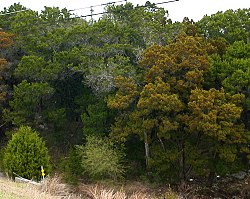Juniperus ashei
| Juniperus ashei | |
|---|---|
 |
|
| J. ashei shedding pollen: mature male on right, immature tree on left, mature green females in background | |
| Scientific classification | |
| Kingdom: | Plantae |
| Division: | Pinophyta |
| Class: | Pinopsida |
| Order: | Pinales |
| Family: | Cupressaceae |
| Genus: | Juniperus |
| Species: | J. ashei |
| Binomial name | |
|
Juniperus ashei J. Buchholz |
|
 |
|
| Natural range of Juniperus ashei | |
| Synonyms | |
|
J. sabinoides (H.B.K.) Nees sensu Sargent |
|
J. sabinoides (H.B.K.) Nees sensu Sargent
J. mexicana Spreng.
J. monticola Martinez
Sabina sabinoides (H.B.K.) Small
Juniperus ashei (Ashe juniper, post cedar, mountain cedar, or blueberry juniper) is a drought-tolerant evergreen tree, native to northeastern Mexico and the south-central United States north to southern Missouri; the largest areas are in central Texas, where extensive stands occur. It grows up to 10 metres (33 ft) tall, rarely 15 metres (49 ft), and provides erosion control and year-round shade for wildlife and .
The feathery foliage grows in dense sprays, bright green in color. The leaves are scale-like, 2 to 5 millimetres (0.079 to 0.197 in) long, and produced on rounded (not flattened) shoots. It is a dioecious species, with separate male and female plants. The seed cones are round, 3 to 5 millimetres (0.12 to 0.20 in) long, and soft, pulpy and berry-like, green at first, maturing purple about 8 months after pollination. They contain 1-2 seeds, which are dispersed when birds eat the cones and pass the seeds in their droppings. The male cones are 3–5 mm long, yellow, turning brown after pollen release in December to February.
The pollen causes a severe allergic reaction for some people in the winter, and people who are allergic to Ashe juniper are also often allergic to the related Juniperus virginiana. Consequently, what begins as an allergy in the winter may extend into spring since the pollination of J. virginiana follows that of J. ashei. Ashe juniper is sometimes known in the area as "mountain cedar" (although neither it nor J. virginiana are cedars), and locals usually refer to the allergy as cedar fever. Left untreated, symptoms of cedar fever may develop into a more severe infection such as pneumonia. The allergy itself seems to be most prevalent among transplant residents who resided in northeastern states for most of their lives, but can affect even locals who have resided there all their lives and are only now developing an allergy.
...
Wikipedia

